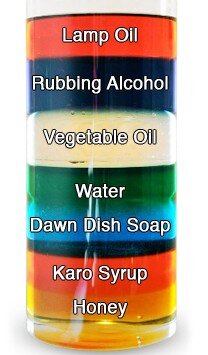Science experiments for children – Density column – An easy and effective experiment to demonstrate the density of the liquid.
Science experiments for children – Density column
What do you need?
– A high and narrow glass vase,
– An assortment of liquids of different densities (honey, liquid detergent, water, oil, alcohol, etc …),
– food colorings (optional).
You can get a similar resulting preparing solutions of salt and water at different concentrations, and each colored with a different color; for example by adding multiples of 5 teaspoons of salt for each level (from 5 for the most dense to 0 for the less dense).
The column can also be used to measure solids immersed in column (raisins, paper clips, coins, stones, cork, a ball of paper, etc …), observing at what point of the column they stop.
_________________
Science experiments for children – Density column
What to do?
Pour slowly, one by one, the various liquids in the jar, beginning with the most dense.

_________________________
Science experiments for children – Density column
What happens?
Why the objects that are the same size sometimes have different weights?
The answer has to do with their density.
If you compare a stone and a piece of cork, which are the same size (ie have the same volume), what is the heaviest? The stone, because it has more mass. The stone is more dense than cork, because it has more mass in the same volume.
Even liquids have different densities, just as solids.
___________________
Science experiments for children – Density column
Video
_____________________
Science experiments for children – Density column
Other links:
http://www.playbasedlearning.com.au/
http://www.hometrainingtools.com/
http://www.stevespanglerscience.com/